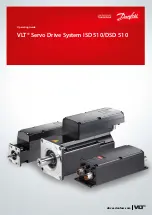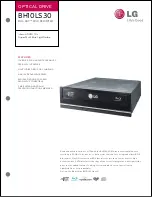
Geo MACRO Drive User and Reference Manual
Connections
23
Wiring AC Input, J1
The main bus voltage supply is brought to the Geo drive through connector J1. 1.5A continuous and 3A
continuous Geo drives can be run off single-phase power. It is acceptable to bring the single-phase power
into any two of the three input pins on connector J1. Higher-power drive amplifiers require three-phase
input power. It is extremely important to provide fuse protection or overload protection to the input
power to the Geo drive amplifier. Typically, this is provided with fuses designed to be slow acting, such
as FRN-type fuses. Due to the various regulations of local codes, NEC codes, UL and CE requirements,
it is very important to reference these requirements before making a determination of how the input power
is wired.
Additionally, many systems require that the power be able to be turned on and off in the cabinet. It is
typical that the AC power is run through some kind of main control contact within the cabinet, through
the fuses, and then fed to a Geo drive. If multiple Geo drives are used, it is important that each drive has
its own separate fuse block.
Whether single- or three-phase, it is important that the AC input wires be twisted together to eliminate
noise radiation as much as possible. Additionally, some applications may have further agency noise
reduction requirements that require that these lines be fed from an input filtering network.
The AC connections from the fuse block to the Geo drive are made via a cable that is either purchased as
an option from Delta Tau (CABKITxx) or made with the appropriate connector kit (CONKITxx).
(Appendix A)
J1: AC Input Connector Pinout
Pin #
Symbol
Function
Description
Notes
1
L3
Input
Line Input Phase 3
2
L2
Input
Line Input Phase 2
3
L1
Input
Line Input Phase 1
(not used for single Phase Input)
On Gxx201xx and Gxx301xx, there is a fourth pin for Ground connection.
If DC bus is used, use L3 for DC+ and L2 for DC return.
Connector is located at the bottom side of the unit.
Wiring Earth-Ground
Panel wiring requires that a central earth-ground location be installed at one part of the panel. This
electrical ground connection allows for each device within the enclosure to have a separate wire brought
back to the central wire location. Usually, the ground connection is a copper plate directly bonded to the
back panel or a copper strip with multiple screw locations. The Geo drive is brought to the earth-ground
via a wire connected to the M4 stud (5mm thread) on the top of the location through a heavy gauge,
multi-strand conductor to the central earth-ground location. On some models, a fourth pin is provided on
the 3-phase AC input connector (J1) and on the motor output connectors to provide a ground connection.
Earth Grounding Paths
High-frequency noises from the PWM controlled power stage will find a path back to the drive. It is best
that the path for the high-frequency noises be controlled by careful installation practices. The major
failure in problematic installations is the failure to recognize that wire conductors have impedances at
high frequencies. What reads 0 ohms on a handheld meter may be hundreds of ohms at 30MHz.
Consider the following during installation planning:
1. Star point all ground connections. Each device wired to earth ground should have its own conductor
brought directly back to the central earth ground plate.
2. Use unpainted back panels. This allows a wide area of contact for all metallic surfaces reducing high
frequency impedances.
3. Conductors made up of many strands of fine conducts outperform solid or conductors with few
strands at high frequencies.
Summary of Contents for Geo MACRO
Page 2: ......
Page 6: ......
Page 18: ...Geo MACRO Drive User Manual 6 Introduction...
Page 26: ...Geo MACRO Drive User Manual 14 Specifications...
Page 28: ...Geo MACRO Drive User Manual 16 Receiving and Unpacking...
Page 78: ...Geo MACRO Drive User Manual 66 Software Setup...
Page 88: ...Geo MACRO Drive User Manual 76 Setting Up Secondary Encoders...
Page 90: ...Geo MACRO Drive User Manual 78 Setting Up Turbo PMAC Conversion Table...
Page 110: ...Geo MACRO Drive User Manual 98 Setting Up Turbo Motor Operation...
Page 130: ...Geo MACRO Drive User Manual 118 Troubleshooting...
Page 175: ...Geo MACRO Drive User and Reference Manual Absolute Power On Online Commands 163...
Page 176: ...Geo MACRO Drive User Manual 164 Useful Notes...
Page 177: ...Geo MACRO Drive User and Reference Manual Appendix A 165...
Page 182: ...Geo MACRO Drive User Manual 170 Appendix A Cable Drawings...
Page 183: ...Geo MACRO Drive User and Reference Manual Appendix A 171...
Page 184: ...Geo MACRO Drive User Manual 172 Appendix A...
Page 185: ...Geo MACRO Drive User and Reference Manual Appendix A 173...
Page 186: ...Geo MACRO Drive User Manual 174 Appendix A...
Page 187: ...Geo MACRO Drive User and Reference Manual Appendix A 175...
Page 191: ...Geo MACRO Drive User and Reference Manual Appendix A 179...
Page 197: ...Geo MACRO Drive User and Reference Manual Appendix C 185...
















































